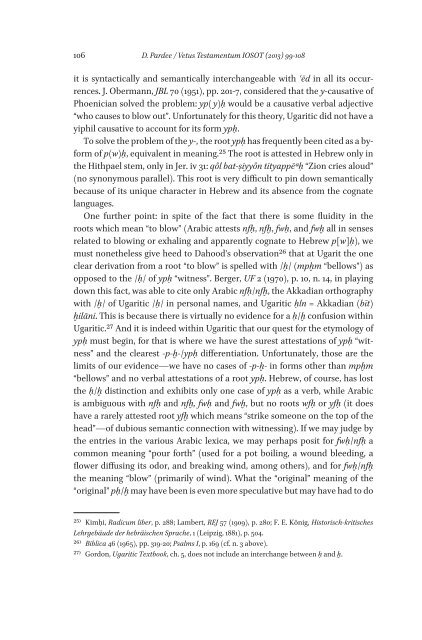Special Issue IOSOT 2013 - Books and Journals
Special Issue IOSOT 2013 - Books and Journals
Special Issue IOSOT 2013 - Books and Journals
Create successful ePaper yourself
Turn your PDF publications into a flip-book with our unique Google optimized e-Paper software.
106 D. Pardee / Vetus Testamentum <strong>IOSOT</strong> (<strong>2013</strong>) 99-108<br />
it is syntactically <strong>and</strong> semantically interchangeable with ʿēd in all its occurrences.<br />
J. Obermann, JBL 70 (1951), pp. 201-7, considered that the y-causative of<br />
Phoenician solved the problem: yp( y)ḥ would be a causative verbal adjective<br />
“who causes to blow out”. Unfortunately for this theory, Ugaritic did not have a<br />
yiphil causative to account for its form ypḥ.<br />
To solve the problem of the y-, the root ypḥ has frequently been cited as a byform<br />
of p(w)ḥ, equivalent in meaning.25 The root is attested in Hebrew only in<br />
the Hithpael stem, only in Jer. iv 31: qôl bat-ṣiyyôn tityappēaḥ “Zion cries aloud”<br />
(no synonymous parallel). This root is very difficult to pin down semantically<br />
because of its unique character in Hebrew <strong>and</strong> its absence from the cognate<br />
languages.<br />
One further point: in spite of the fact that there is some fluidity in the<br />
roots which mean “to blow” (Arabic attests nfḥ, nfḫ, fwḥ, <strong>and</strong> fwḫ all in senses<br />
related to blowing or exhaling <strong>and</strong> apparently cognate to Hebrew p[w]ḥ), we<br />
must nonetheless give heed to Dahood’s observation26 that at Ugarit the one<br />
clear derivation from a root “to blow” is spelled with /ḫ/ (mpḫm “bellows”) as<br />
opposed to the /ḥ/ of ypḥ “witness”. Berger, UF 2 (1970), p. 10, n. 14, in playing<br />
down this fact, was able to cite only Arabic nfḥ/nfḫ, the Akkadian orthography<br />
with /ḫ/ of Ugaritic /ḥ/ in personal names, <strong>and</strong> Ugaritic ḥln = Akkadian (bīt)<br />
ḫilāni. This is because there is virtually no evidence for a ḥ/ḫ confusion within<br />
Ugaritic.27 And it is indeed within Ugaritic that our quest for the etymology of<br />
ypḥ must begin, for that is where we have the surest attestations of ypḥ “witness”<br />
<strong>and</strong> the clearest -p-ḫ-/ypḥ differentiation. Unfortunately, those are the<br />
limits of our evidence—we have no cases of -p-ḫ- in forms other than mpḫm<br />
“bellows” <strong>and</strong> no verbal attestations of a root ypḥ. Hebrew, of course, has lost<br />
the ḥ/ḫ distinction <strong>and</strong> exhibits only one case of ypḥ as a verb, while Arabic<br />
is ambiguous with nfḥ <strong>and</strong> nfḫ, fwḥ <strong>and</strong> fwḫ, but no roots wfḥ or yfḥ (it does<br />
have a rarely attested root yfḫ which means “strike someone on the top of the<br />
head”—of dubious semantic connection with witnessing). If we may judge by<br />
the entries in the various Arabic lexica, we may perhaps posit for fwḥ/nfḥ a<br />
common meaning “pour forth” (used for a pot boiling, a wound bleeding, a<br />
flower diffusing its odor, <strong>and</strong> breaking wind, among others), <strong>and</strong> for fwḫ/nfḫ<br />
the meaning “blow” (primarily of wind). What the “original” meaning of the<br />
“original” pḥ/ḫ may have been is even more speculative but may have had to do<br />
25) Kimḥi, Radicum liber, p. 288; Lambert, REJ 57 (1909), p. 280; F. E. König, Historisch-kritisches<br />
Lehrgebäude der hebräischen Sprache, 1 (Leipzig, 1881), p. 504.<br />
26) Biblica 46 (1965), pp. 319-20; Psalms I, p. 169 (cf. n. 3 above).<br />
27) Gordon, Ugaritic Textbook, ch. 5, does not include an interchange between ḥ <strong>and</strong> ḫ.








![Am HaSefer [Volk des Buches] - Books and Journals](https://img.yumpu.com/20648352/1/174x260/am-hasefer-volk-des-buches-books-and-journals.jpg?quality=85)







